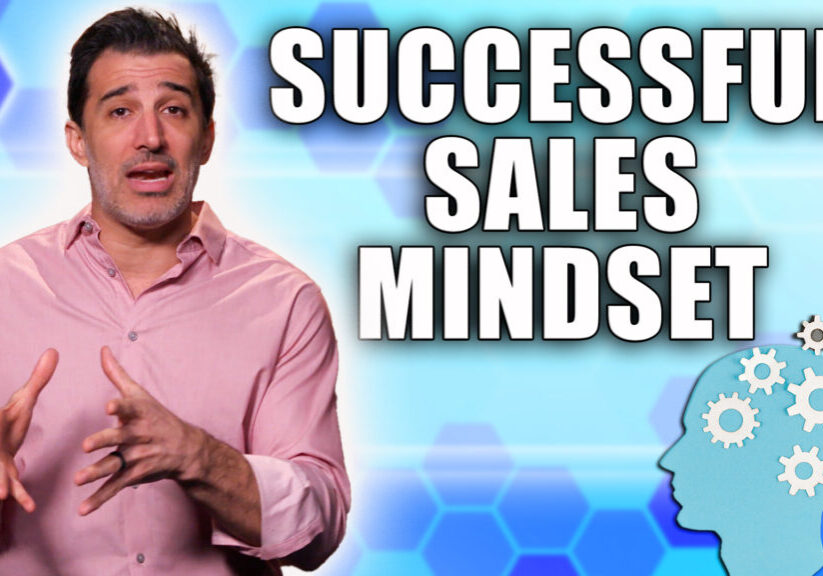As a sales leader, have you noticed the world of sales leadership changing all around you?
Chances are, you’ve already experienced some major shifts in sales leadership over the past few years alone.
I recently sat down with Katie Ng-Mak, VP of Global Partner Strategy and Operations at HubSpot, to talk about how a world-class sales leader must adapt to the future of selling.
Katie brings a wealth of unique experience and powerful insight to sales leadership, having earned her MBA from Harvard Business School and worked in finance before landing at HubSpot. Today, she leads a large organization by following some of the exact strategies we’ll cover in the video below.
Learn what new skill sets and tools will be par for the course for sales leadership in just a few short years—if they aren’t already. Check it out:
Video Summary:
In this wide-ranging interview with Katie Ng-Mak, you’ll learn the keys to how a world-class sales leader must adapt to the future of selling in order to remain effective, relevant, and successful.
Sales leadership standards are changing rapidly in virtually every industry, and hardly anyone is prepared. Are you? Continue on to read our discussion about the strategies and skills required of modern, forward-thinking sales leadership.
Marc Wayshak: Katie, what do you see is changing for sales leadership, in terms of the demands and requirements of a world-class sales leader today?
Katie Ng-Mak: That’s a great question. When people think about sales leadership, or the typical salesperson, they think of someone who’s really great with people—someone who’s really great with relationships. I still think that’s super important, because people who are in sales need to be great at knowing what makes people tick.
But while the modern-day sales leader needs to have those skills, they also need to be very operationally driven and process-oriented. The modern-day sales leader needs to have more skills under their belt.
Wayshak: That makes sense. It’s no longer this idea of the archetypal, schmoozing sales leader who’s really charismatic. It goes deeper than that. When you talk about the need for sales leadership to be operationally driven and process-oriented, what do you mean by that?
Ng-Mak: Let me give you an example. When I started in sales 10 years ago, the way I was told to make sales was to pick up the phone and send emails. Those were the two tools that I used. Then I would look at how many dials I made, how many emails I sent, and how many connects I made. And from there, I would look at how many opportunities came from that, how many presentations did I give, how many deals did I close. It was actually fairly simple, but back then, you would have been considered sophisticated if you knew all those metrics.
Today, I think it’s much more complicated. Let’s say I had my reps trying to build up their pipelines. They would pick up the phone, they would send emails, they would send videos, they would try to connect with prospects via text messaging, and via chat. The thing is that you need to meet prospects where they are nowadays. And you need to engage them how they want to be engaged.
Just off the bat, I named several new ways by which you can engage to connect. All of a sudden, your entire operating system is more complicated. So, as a sales leader, you actually need to understand all of that—and then you need to figure out, “What are the different tools that my team needs? How do I enable them on these tools? How do I attract the engagement of all of that? And then how does that impact the rest of my process?”
These days, you need sales leadership who can make these calls in a changing sales environment. Someone who knows tools better, can build a process, and really do much more complicated enablement—and then figure out how to track all of this stuff, read the data, and call the next play.
Wayshak: This definitely aligns with what I’m seeing in the field with sales leadership. There are obviously far more mediums through which we need to be connecting with prospects today. That’s a given. I think the organizations that I see that are successful are, like you said, able to build processes around that. And that’s a big task, to build processes around not only what tools people should be using, but also how to track it and how to do it in a way that makes it systematic.
What would be a strategy that sales leadership could use to tie all this together? So that, if a sales leader has a team of 15 SDRs, they’re not just all off using the tools in any way they please?
Ng-Mak: I think it kind of depends on the organization. I would say the first thing is that, as a sales leader, you need to determine whether you have the operational capabilities. If you don’t have them, then you need a really strong operational partner. You can understand the business, but you’ll need someone who can build a lot of this for you.
I would say the second thing is that you need to understand what other people are using. Most of what I’m talking about are just software tools. You really just need a CRM. But you need a CRM that integrates with other software solutions so that you can track this information.
And I would also say the website now can give the CRM a run for its money in terms of how important it is to a business. You need a really robust website. Even if your customers don’t transact on the website, they engage you on the website. And you need to be able to track that engagement back to the information that your salespeople see in the CRM. You need those two systems to talk to each other.
You also need sales leadership that understands both systems—or at least have partners who do, so that someone can put the picture together.
Wayshak: Yeah. Even if you’re not a tech-savvy person, you can at least understand the dashboard and have someone who can set that up for you to measure those key metrics.
What would you say are some of the key tools that today’s sales leadership has to either master themselves, or have access to someone who can master? You mentioned already CRM, website, and the capacity to tie those together. What else?
Ng-Mak: I would say a set of sales enablement tools. I work with HubSpot and we have a bunch of capabilities there. I think there are tons of different players there. What’s important is the ability to integrate everything together, if you’re using different pieces of software.
We have some really good call recording software at HubSpot, and that is phenomenal for coaching. It gives managers the ability to get perspective on what types of conversations are happening. It also shows them what prospects are saying. And then they can glean that insight and know whether they need to start pivoting.
Wayshak: Now that we have an understanding of some of the key tools sales leadership needs today, what metrics should they be measuring? You mentioned at the beginning that 10 years ago you had to measure things like the number of calls and the opportunities in the pipeline. What are some of those key metrics nowadays that sales leadership should really be focused on?
Ng-Mak: I can tell you one that we’re looking to track here at HubSpot: how many referrals we get from our customers. We’re trying to figure out a really efficient and smart way to do it. Because one of the things we realize is that our customers are our best source of growth.
We believe that our customers are amplifying our reach in the marketplace. Right now we’re trying to figure out how we can track that reach. Through the website we can track how many visitors come through. But we need to figure out how to track when those visitors are coming through our customers. How do we understand and track it back to the referral?
The other way I think about reporting and KPIs is that it’s not just choosing specific KPIs, it’s actually thinking about reporting, not as something that’s static, but as something that you can really drill down on. For my team, the way we used to do reporting was to take high-level reports and then copy and paste screenshots in there to do a business review. With my team now, I’m actually changing the reporting this year whereby we have a set of static reports, but in the static reports there are so many links that bring you into drilled-down reports.
I have a global business, so you can look at the same view, the same metric, on a regional, country, team, and rep level—and then I think those provide you with the trends that help you figure out the very specific KPIs that are the leverage of your business. And then you can constantly just change up what you’re tracking.
Wayshak: That’s so interesting. I see so many clients who literally have a sales assistant export the data into an Excel spreadsheet, and then it’s a static piece of information they can’t do anything with. But most CRMs nowadays have the ability to drill down so you can really understand what’s going on.
You mentioned to me earlier, before we started this interview, the idea of a pipeline scientist. You said that a world-class sales leader has to be a pipeline scientist to adapt to the future of selling. Help me understand what that means for sales leadership today.
Ng-Mak: My former boss, Mark Roberge [former CRO of HubSpot], introduced the term pipeline scientist. It’s a really neat term. It brings attention to the fact that you actually can understand what would be the output of your entire sales team through looking at metrics. Which also means that you need to be able to track the activities of your sales organization.
I still talk to sales teams that run their businesses out of spreadsheets. If you do that, number one, you lose that knowledge as soon as the person who owns that spreadsheet leaves the organization. And number two, there’s no way to aggregate data and capture insights when your business is spread across 10 different spreadsheets, across 10 different people, who are probably managing it all in different ways.
I would say that being a pipeline scientist is about, first, having a methodology where all the sales reps on your team are logging their sales activities. They’re also using the same set of expectations around what to log. And second, you, as a sales leader, can take an aggregate view of all those activities and figure out what’s working well and what’s not. Then you can make business decisions to try to make your sales process more efficient.
Having that understanding allows you to spend energy on the parts of the sales process that get you leverage and help you drive to better outcomes.
Wayshak: One of the things that sales leadership wants to avoid is just stopping by someone’s desk and asking, “Oh, what have you been working on?” If you are effectively using your CRM, you should already know the answer. What’s amazing is that, if you’re not using a CRM and understanding what’s coming into the pipeline, salespeople are using notebooks to keep track of some stuff and a spreadsheet to track some other stuff, and it’s not happening in one place. It’s such a lost opportunity.
Ng-Mak: Yeah. You also don’t want to go to a sales rep and say, “Do more calls.” You can get more output through that, but you can probably get more efficient output if you tell them, “Do more calls but also do this differently.” I think that insight can help them be a more productive salesperson, and help you run a more productive team.
Wayshak: Totally. Also, if you can be tracking the types of people that they’re making calls to, then you can really hone in so much more. I love this. This is so valuable.
Just to tie it up, what would you say are one or two real tangible things that sales leadership can be doing today to improve the productivity of their sales organizations?
Ng-Mak: My advice to other sales leaders out there, in general, would be that if you don’t have a strong analytical background, spend time on activities that will allow you to build some of those skills. For example, I encourage my team of managers to spend time on operationally heavy projects, like projects that involve looking at a lot of data, learning how to pull the data, learning how to run the business through gathering insights on that data. That in itself is such an important skill set. I think it’s going to be the baseline requirement of any sales leader in the future.
You could probably get away with not having that skill set right now, but I think within a couple of years that’s going to be the expectation. If you’re going to be a sales leader, you need to be great with relationships, you need to be great at managing people, but, man, you better be able to identify the opportunities in your business through a set of data and figure out how to pivot it.
Wayshak: Yeah, I love to see that trend. I see it in my work. The archetypal image of sales leadership is becoming nerdier and nerdier, which I think is really cool. In 1980 that image was totally Glengarry Glen Ross. Alec Baldwin coming in really hardcore. And now I think we see that it’s so much more nuanced.
We live in this amazing age where there is so much powerful data out there. If you’re not utilizing it, you’re missing out on so much.
Ng-Mak: Yeah. The businesses that use the data will understand customers better. And if your customers are convinced that you understand them better, they will trust you more and you will win their business.
Wayshak: That’s so powerful. There’s a direct line between understanding the data and ultimately increasing sales.
Well, Katie, this has been fantastic. I’m so grateful for you talking to us today. Thank you.
Ng-Mak: Thank you for your time.
So, there you have it. That’s my interview with Katie Ng-Mack, VP of Global Partner Strategy and Operations at HubSpot, on how a world-class sales leader must adapt to the future of selling.
I want to hear from you. Which of these ideas about sales leadership did you find most useful? Be sure to share below in the comments section to get involved in the conversation.
Enjoyed this article? Please share away!

Get instant access to our free sales training:
Why Prospects Push Back on Price, Give 'Think-It-Overs,' and Ghost in Sales Until They Meet a Sales Superstar Who Is Following These 7 Simple Keys

About the Author Marc Wayshak
Marc is is the best-selling author of three books on sales and leadership, including the highly acclaimed titles Game Plan Selling, The High-Velocity Sales Organization and his forthcoming book, Sales Conversations, Mastered.
Marc is a contributor to Inc, HubSpot, Fast Company, Entrepreneur Magazine, and Huffington Post Business. He also hosts a popular YouTube channel on sales strategy with over 103,000 subscribers.
Marc helps thousands of people his data-driven, science-based approach to selling that utilizes all the best tools available to sales organizations today.



![How-to Sell to Power [C-Suite Sales Must-Knows!] How to Sell to Power [C-Suite Sales Must-Knows!]](https://salesinsightslab.com/wp-content/uploads/bb-plugin/cache/How-to-Sell-to-Power-C-Suite-Sales-Must-Knows-1024x576-landscape-7a52c541b28a7b772ad9e1010d8240be-.jpg)


![The Absolute Best Way to Start a Sales Conversation [WITH ANY PROSPECT] The Absolute Best Way to Start a Sales Conversation [WITH ANY PROSPECT]](https://salesinsightslab.com/wp-content/uploads/bb-plugin/cache/The-Absolute-Best-Way-to-Start-a-Sales-Conversation-WITH-ANY-PROSPECT-1024x576-landscape-be9d9379ab94d9f71b5bfeed42246a84-.jpg)